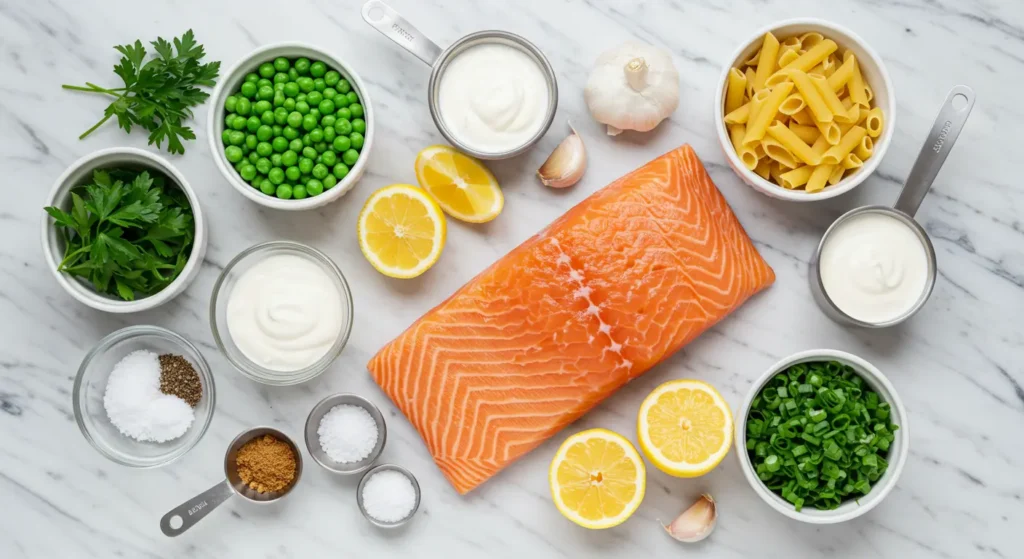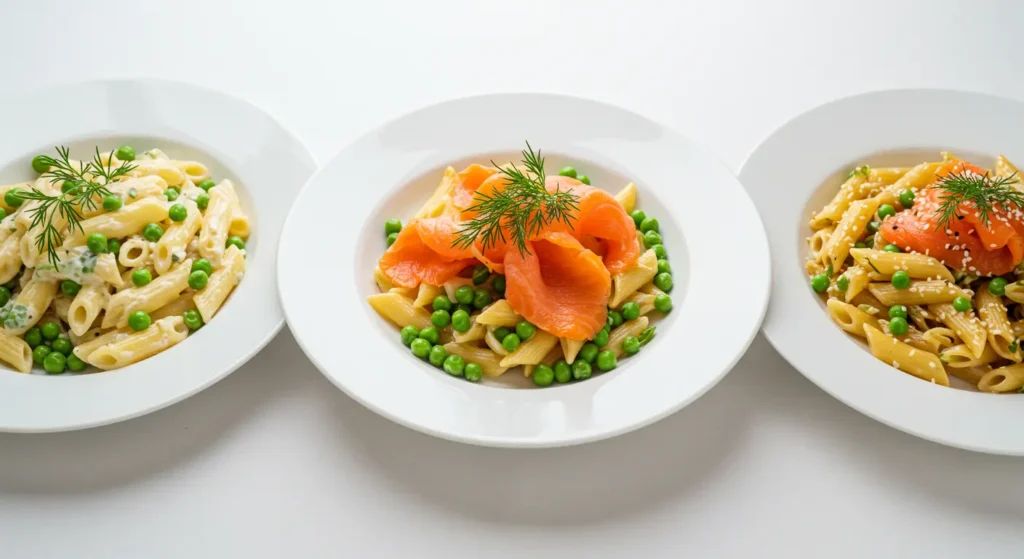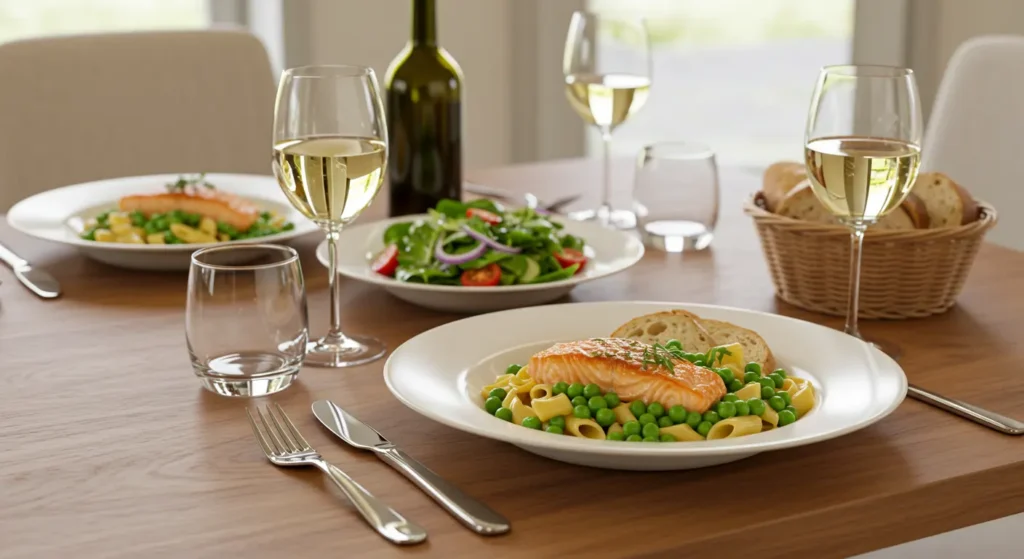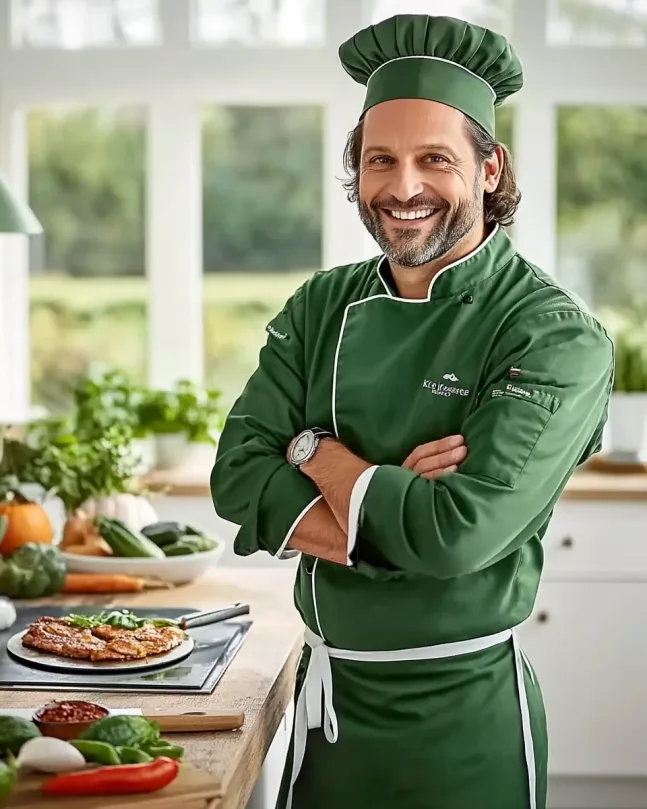Pasta with Salmon Peas – Why This Recipe?
When I first discovered the magical combination of pasta with salmon and peas, I was working as a sous chef in a small Italian restaurant on the coast of Maine. The owner’s grandmother would prepare this dish every Sunday using freshly caught Atlantic salmon and the sweetest spring peas from her garden. The first time I tasted it, I was captivated by how these simple ingredients created something truly extraordinary.
As Chef Greeny, I’ve spent years perfecting my version of this classic combination. What began as a professional curiosity evolved into a personal obsession as I experimented with different pasta shapes, salmon cooking techniques, and sauce variations. This dish has become my go-to recommendation for home cooks looking to impress without spending hours in the kitchen.
What makes pasta with salmon peas so special is its perfect balance: the rich, tender salmon provides omega-3 fatty acids and protein; the sweet peas add vibrant color and freshness; and the pasta brings comforting familiarity. All tied together with a sauce that can range from light and lemony to rich and creamy depending on your preference.
In this comprehensive guide, I’ll share my perfected recipe along with professional techniques to ensure perfectly cooked salmon every time. You’ll learn how to create a harmonious dish that’s elegant enough for special occasions yet simple enough for weeknight dinners. Plus, I’ll offer variations to accommodate different dietary needs and flavor preferences.
Pasta with Salmon Peas – Ingredients and Preparation
Ingredients List

For the pasta and main components:
- 12 oz (340g) pasta (fettuccine, penne, or farfalle work well)
- 1 lb (450g) fresh salmon fillet, skin removed
- 1 cup (150g) fresh or frozen peas
- 2 tablespoons olive oil
- 3 cloves garlic, minced
- 1 shallot, finely diced
- 1/2 cup (120ml) dry white wine (such as Pinot Grigio or Sauvignon Blanc)
- Zest and juice of 1 lemon
For the sauce:
- 3/4 cup (180ml) heavy cream
- 1/4 cup (60ml) pasta cooking water (reserved)
- 2 tablespoons unsalted butter
- 1/3 cup (30g) freshly grated Parmesan cheese, plus extra for serving
- 2 tablespoons fresh dill, chopped
- 2 tablespoons fresh parsley, chopped
- Salt and freshly ground black pepper, to taste
- Pinch of red pepper flakes (optional)
Substitution options:
- Gluten-free: Use gluten-free pasta made from rice, corn, or chickpea flour
- Dairy-free: Replace heavy cream with full-fat coconut milk and substitute vegan butter and nutritional yeast for the Parmesan
- Lower calorie: Use half-and-half instead of heavy cream and reduce butter to 1 tablespoon
- Seafood alternatives: Smoked salmon or canned salmon can work in a pinch, though cooking methods will differ
Step-by-Step Instructions
- Prepare the salmon: Pat the salmon dry with paper towels and season generously with salt and pepper on both sides. Cut into 1-inch cubes. Chef’s tip: For the best texture, avoid cutting the salmon too small, as it can overcook quickly and become dry.
- Cook the pasta: Bring a large pot of heavily salted water to a boil (it should taste like sea water). Cook pasta according to package directions until al dente. During the last minute of cooking, add the peas to the pasta water. Before draining, reserve 1/2 cup of the starchy pasta water. Chef’s tip: Always cook pasta 1 minute less than package instructions for the perfect al dente texture that will finish cooking in the sauce.
- Prepare the salmon while pasta cooks: Heat olive oil in a large skillet over medium-high heat. When oil is shimmering but not smoking, carefully add the salmon cubes. Cook without moving for about 2 minutes to develop a golden crust on one side, then gently flip and cook for another 1-2 minutes until just barely cooked through. Transfer salmon to a plate and set aside. Chef’s tip: The salmon should still be slightly translucent in the center as it will continue cooking from residual heat and will be returned to the pan briefly.
- Start the sauce: In the same skillet (don’t clean it), reduce heat to medium and add another tablespoon of olive oil if needed. Add shallots and cook for 2-3 minutes until translucent, then add garlic and cook for 30 seconds until fragrant but not browned.
- Deglaze and build the sauce: Pour in the white wine, scraping up any browned bits from the bottom of the pan with a wooden spoon. Let the wine simmer and reduce by half, about 2-3 minutes. Add lemon zest and juice, then pour in the heavy cream. Bring to a gentle simmer and cook for 2-3 minutes until slightly thickened.
- Combine everything: Lower the heat to medium-low. Add the drained pasta and peas to the skillet with the sauce. Add the reserved pasta water, butter, and grated Parmesan. Toss gently to coat pasta evenly. Carefully fold in the salmon cubes and fresh herbs, being careful not to break up the salmon too much.
- Final seasoning: Taste and adjust seasoning with salt, pepper, and red pepper flakes if desired. If the sauce seems too thick, add a splash more pasta water to reach your desired consistency.
- Serve immediately: Portion onto warmed plates and garnish with additional Parmesan cheese, a sprinkle of herbs, and freshly ground black pepper.

Notes and Tips
Storage tips:
- This dish is best enjoyed fresh, but leftovers can be refrigerated in an airtight container for up to 2 days.
- When reheating, add a splash of milk or cream and warm gently over low heat to prevent the sauce from separating.
- I don’t recommend freezing this dish as both the pasta texture and cream sauce can become compromised when thawed.
Serving suggestions:
- Serve with a simple green salad dressed with lemon vinaigrette
- Garlic bread or focaccia makes an excellent accompaniment
- A chilled glass of the same white wine used in cooking complements the dish beautifully
Make-ahead options:
- The salmon can be seasoned up to 8 hours in advance and kept refrigerated
- The sauce base (before adding cream) can be prepared earlier in the day
- For a dinner party, have all components ready and perform the final assembly just before serving
Pasta with Salmon Peas – Nutritional Information
Nutrition Facts (Per Serving)
Based on 4 servings:
- Calories: 675
- Carbohydrates: 65g
- Protein: 35g
- Total Fat: 28g
- Saturated Fat: 12g
- Unsaturated Fat: 14g
- Trans Fat: 0g
- Fiber: 4g
- Sugar: 3g
- Cholesterol: 115mg
- Sodium: 320mg
This dish provides an excellent source of protein, omega-3 fatty acids from the salmon, and a good balance of carbohydrates. The peas add fiber and essential vitamins while keeping the dish balanced.
Pasta with Salmon Peas – History and Cultural Significance
Pasta with salmon and peas represents a beautiful marriage between Italian pasta traditions and the seafood abundance found in coastal regions. While not strictly a classic Italian combination in the historical sense, this dish embodies the Italian philosophy of using fresh, high-quality ingredients prepared simply to let their natural flavors shine.
The pairing of pasta with seafood dates back centuries in Italy, particularly in coastal regions like Sicily, Sardinia, and Liguria. Traditional Italian cuisine has always emphasized using local, seasonal ingredients, which is why you’ll find regional variations of seafood pasta throughout the country.
The addition of peas speaks to the dish’s adaptability with seasonal produce. Spring in Italy brings sweet, tender peas that have been celebrated in Italian cuisine for generations. The combination gained popularity internationally during the mid-20th century as Italian cuisine became more globalized and chefs began experimenting with fusion elements.
Similar dishes appear in various forms across European cuisines. In France, salmon and peas might appear with pasta in a beurre blanc sauce, while Scandinavian cuisine often pairs salmon with cream and dill in various preparations. The British have long celebrated the salmon-and-pea combination, though traditionally not with pasta.
What makes pasta with salmon peas so beloved worldwide is its perfect balance of nutrition, flavor, and visual appeal. The dish represents the global trend toward healthier eating while maintaining comfort food status – satisfying and nourishing without being heavy.
Pasta with Salmon Peas – Creative Variations
Lemon Dill Pasta with Smoked Salmon and Peas
For a no-cook alternative that’s perfect for summer:
- Replace fresh salmon with 8 oz of high-quality smoked salmon, torn into pieces
- Skip the cooking steps and create a cold sauce by mixing: 1/2 cup Greek yogurt, 1/4 cup olive oil, 2 tablespoons lemon juice, 1 tablespoon honey, and 3 tablespoons fresh dill
- Blanch peas separately and shock in ice water to preserve their bright green color
- Toss cooked, cooled pasta with the yogurt sauce, then gently fold in smoked salmon and peas
- Finish with extra lemon zest, capers, and thinly sliced radishes for a fresh crunch
This variation is lighter, requires minimal cooking, and offers a tangy alternative to the creamy original.
Asian-Inspired Pasta with Salmon Peas
For an east-meets-west fusion twist:
- Marinate salmon cubes in 2 tablespoons soy sauce, 1 tablespoon rice vinegar, 1 teaspoon sesame oil, and 1 teaspoon grated ginger for 15 minutes before cooking
- Replace white wine with sake or mirin in the sauce
- Add 1 tablespoon of miso paste to the cream sauce (or use coconut milk instead of cream)
- Mix in 1 cup of thinly sliced snow peas or sugar snap peas along with the regular peas
- Garnish with sliced scallions, sesame seeds, and a drizzle of chili oil
- Consider using soba noodles or udon instead of Italian pasta
This variation introduces umami flavors and textural contrasts while maintaining the core elements of the dish.
Adapting for Special Dietary Needs
For dairy-free/paleo version:
- Use zucchini noodles or sweet potato noodles instead of pasta
- Replace cream sauce with a mixture of 1 can full-fat coconut milk reduced by half with 1/4 cup chicken broth
- Add 1 tablespoon arrowroot powder dissolved in 1 tablespoon water to thicken
- Enhance flavor with nutritional yeast instead of Parmesan
- Increase herbs and add 1 teaspoon of lemon zest to compensate for the missing richness
For a budget-friendly version:
- Use canned salmon, drained and flaked (about 2 cans)
- Replace fresh peas with frozen (more economical and often sweeter)
- Use half-and-half instead of heavy cream
- Incorporate more pasta and stretch the salmon further by adding 1 cup of sautéed mushrooms
Pasta with Salmon Peas – Frequently Asked Questions

What type of pasta works best with salmon and peas?
Medium shapes that can catch sauce work wonderfully with this dish. My top recommendations are:
- Farfalle (bow ties): The flat surface area holds sauce well while the shape complements the peas visually
- Orecchiette: The little “ears” catch peas and bits of salmon perfectly
- Fusilli or rotini: The spirals trap creamy sauce beautifully
- Penne: The tube shape captures sauce inside and out
For a more traditional approach, long pasta like fettuccine or linguine creates an elegant presentation, though you’ll need to be more careful when folding in the salmon.
Can I use frozen salmon instead of fresh?
Yes, frozen salmon can work well, but follow these steps for best results:
- Thaw completely in the refrigerator overnight (never at room temperature)
- Pat very dry with paper towels to remove excess moisture
- Let it come to room temperature for 15 minutes before cooking
- You may need to cook slightly longer, but still be careful not to overcook
Frozen salmon can sometimes release more water during cooking, so you might need to adjust your sauce consistency accordingly.
How do I prevent my cream sauce from breaking or separating?
To maintain a smooth, silky cream sauce:
- Use room-temperature cream, not cold from the refrigerator
- Keep heat moderate to low when adding dairy components – never boil the cream
- If adding lemon juice, do so gradually and off the heat
- The starchy pasta water contains natural emulsifiers that help stabilize the sauce
- If the sauce looks like it’s beginning to separate, immediately remove from heat and whisk in a tablespoon of cold butter
Can I make this dish ahead of time for a dinner party?
This dish is best prepared fresh, but you can prepare components ahead:
- Cut and season the salmon, storing it covered in the refrigerator up to 8 hours
- Cook pasta until slightly undercooked (more al dente than usual), toss with a touch of olive oil, and refrigerate
- Make the sauce base through the wine reduction step
- Have peas measured and ready
30 minutes before serving, reheat the sauce base, cook the salmon, warm the pasta with a splash of hot water, and assemble as directed. This approach gives you the best texture while reducing last-minute stress.
Pasta with Salmon Peas – Final Thoughts
Pasta with salmon peas represents the perfect intersection of elegance and simplicity in home cooking. What I love most about this dish is how it transforms everyday ingredients into something that feels special – perfect for both Tuesday night dinners and Saturday dinner parties.
The key to success lies in respecting each component: cooking the pasta properly, treating the salmon gently, and creating a sauce that brings everything together without overwhelming the delicate flavors. With a few quality ingredients and proper technique, anyone can create restaurant-worthy results.
I encourage you to start with the classic version I’ve shared, then experiment with the variations based on your preferences and available ingredients. Cooking should be creative and adaptable, and this versatile dish provides the perfect canvas for your culinary expression.
Try adding this pasta with salmon peas to your regular rotation, and I’m confident it will become a favorite for both family meals and entertaining. For more information about the history of pasta and its global significance, check out Wikipedia’s detailed article on pasta.
What’s your favorite way to prepare salmon? Have you tried combining it with pasta before? Leave a comment below sharing your experience or any questions you might have about this delicious combination!
Happy cooking,
Chef Greeny


4 thoughts on “Pasta with Salmon Peas: 5 Extraordinary Ways to Elevate This Classic Dish”